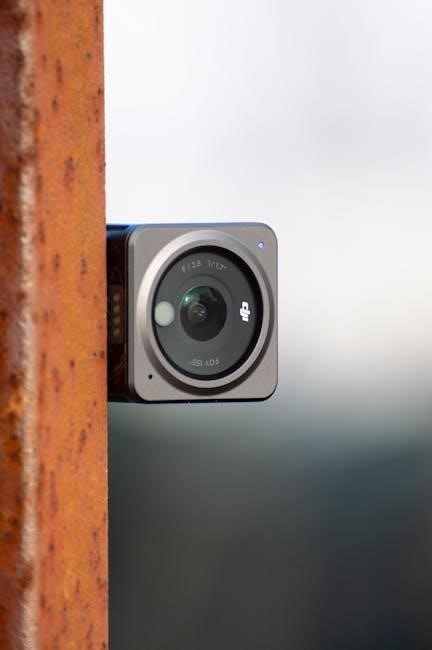Stealth cameras are discreet devices designed for covert surveillance, blending seamlessly into their surroundings. They are essential for security, offering a reliable way to monitor without detection.
1.1 What Are Stealth Cameras?
Stealth cameras are covert surveillance devices designed to capture footage discreetly, often concealed in everyday objects. They are wireless, motion-activated, or strategically hidden to blend into surroundings, ensuring undetected monitoring. These cameras are commonly used for security, wildlife observation, or personal safety, offering a reliable way to gather evidence or monitor activities without being noticed.
1.2 Importance of Stealth Cameras in Security and Surveillance
Stealth cameras play a crucial role in modern security systems by providing discreet monitoring solutions. Their ability to operate undetected makes them highly effective in preventing theft, vandalism, and unauthorized access. These cameras are indispensable for protecting properties, ensuring safety, and gathering evidence without alerting suspects. Their versatility in various settings, from homes to wildlife monitoring, underscores their significance in enhancing security and surveillance efforts.

Choosing the Right Stealth Camera
Selecting the right stealth camera involves considering resolution, battery life, and connectivity options. Ensure it fits your needs for covert surveillance and has features like night vision.
2.1 Types of Stealth Cameras Available
Stealth cameras come in various forms, including trail cameras for wildlife monitoring, wireless models for easy installation, and mini cameras for portability. Some feature motion activation, while others offer night vision capabilities; They can be disguised as everyday objects, like clocks or keychains, ensuring covert surveillance. Each type caters to specific needs, whether for home security, outdoor monitoring, or discreet personal use.
2.2 Features to Look for in a Stealth Camera
Key features include motion detection for alerts, night vision for low-light clarity, and Wi-Fi Direct for remote access. Battery life, storage capacity, and weather resistance are crucial. Ensure the camera supports high-resolution video and has a fast trigger speed. Discreet designs and compatibility with mobile apps enhance functionality. These features ensure effective surveillance while maintaining concealment.
2.3 Budget Considerations
When selecting a stealth camera, consider your budget. Entry-level models offer basic features at affordable prices, while high-end cameras with advanced functionalities require a larger investment. Balance quality and affordability by prioritizing essential features like motion detection and night vision. Additionally, factor in ongoing costs such as data plans or storage subscriptions. Hidden expenses can affect long-term affordability, so plan accordingly.
Installation and Setup
Installing a stealth camera involves securing it in a strategic location, connecting to a power source, and linking to a network for remote access and monitoring.
3.1 Mounting the Camera at the Desired Location
Mounting a stealth camera requires careful placement to ensure optimal viewing angles and concealment. Use strap mounts, articulating ball joints, or other secure mechanisms to position the device. Choose a location that provides a clear field of view while avoiding direct sunlight, which can cause glare or false triggers. Ensure the camera is stable and level for reliable performance.
3.2 Connecting the Camera to Power and Network
Connect your stealth camera to a reliable power source using the provided adapter or batteries. Ensure the device is powered on and functioning correctly. For network connectivity, use Wi-Fi Direct or Ethernet cables to link the camera to your system. Check that the SD card is not write-locked and is properly formatted for smooth operation. Refer to the user guide for specific connection requirements.
3.3 Initial Configuration and Firmware Update
Access the camera’s settings to begin initial configuration. Check for firmware updates and install the latest version to ensure optimal performance. Use the provided software or app to guide you through the update process. Ensure the camera is properly formatted and ready for use. Refer to the user guide for detailed instructions on completing these steps successfully.
Configuring Camera Settings
Configure your stealth camera settings by adjusting motion detection, night vision, and sensitivity. Enable remote access via Wi-Fi Direct for seamless monitoring and real-time updates.
4.1 Adjusting Motion Detection Settings
Adjust motion detection settings to optimize accuracy and reduce false alerts. Set sensitivity levels based on the environment to detect human or vehicle movement effectively. Define detection zones to focus on specific areas, ensuring alerts are relevant. Schedule activation times to monitor only during needed periods, enhancing efficiency and minimizing unnecessary notifications. Regularly review and refine settings for improved performance.
4.2 Setting Up Night Vision and Low-Light Sensitivity
To enhance low-light performance, enable night vision mode, which often uses infrared LEDs for clarity in darkness. Adjust sensitivity settings to reduce overexposure in dim conditions. Position the camera to avoid direct light sources, as this can disrupt night vision. Test the camera in various lighting scenarios and review footage to ensure optimal performance in low-light environments.
4.3 Enabling Wi-Fi Direct for Remote Access
To enable Wi-Fi Direct, open the camera’s settings menu and navigate to the network or wireless options. Select “Wi-Fi Direct” and follow the prompts to activate it. On your mobile device, go to Wi-Fi settings and connect to the camera’s network. Once connected, you can access live footage and configure settings remotely without needing an internet connection.

Troubleshooting Common Issues
Identify common problems like connectivity or power issues. Restart the camera, check connections, and ensure firmware is updated. Consult the manual or contact support if unresolved.
5.1 Diagnosing Power and Connectivity Problems
To diagnose power issues, ensure batteries are charged or replace them if necessary. Check all cables for damage or loose connections. For connectivity, restart the camera and router, then verify Wi-Fi settings. Ensure the camera’s firmware is updated, as outdated versions can cause malfunctions. If issues persist, consult the user manual or contact technical support for further assistance.
5.2 Resolving SD Card and Storage Issues
- Check if the SD card is properly inserted and not write-locked. Ensure it is compatible with your camera.
- Format the SD card using the camera’s settings or a computer to resolve formatting issues.
- If the card is full, delete unnecessary files or expand storage capacity.
- Test the SD card in another device to confirm it is functioning correctly.
5.3 Updating Firmware and Software
To ensure optimal performance, regularly update your stealth camera’s firmware and software. Visit the manufacturer’s website to check for the latest versions. Download updates to your computer, then transfer them to the camera using the provided interface. Ensure the camera is fully powered during installation to avoid interruptions. Updated firmware enhances security, improves functionality, and resolves potential bugs.
Maintenance and Care
Regularly clean the camera lens and housing to ensure clear footage. Check SD cards for storage capacity and format them as needed. Schedule firmware updates to maintain functionality and security.
6.1 Cleaning the Camera Lens and Housing
Use a soft, dry microfiber cloth to gently wipe the lens and housing, avoiding harsh chemicals or abrasive materials. For stubborn smudges, lightly dampen the cloth with distilled water. Regular cleaning ensures optimal image quality and prevents dust buildup. Avoid touching the lens to prevent fingerprints. Clean the camera periodically to maintain its stealth functionality and clarity in surveillance footage.
6.2 Checking and Replacing Batteries
Regularly check battery levels to ensure uninterrupted operation. Look for signs of weakness, such as reduced runtime or dimmed LEDs. Use high-quality, compatible batteries to maintain performance. Replace batteries promptly when they no longer hold a charge. Properly dispose of old batteries and charge new ones fully before installation to ensure optimal camera functionality and reliability in the field.
6.3 Regularly Updating Firmware
Regular firmware updates are crucial for maintaining optimal camera performance and security. Check the manufacturer’s website for the latest updates. Download and install the correct firmware version for your model. Outdated firmware can lead to malfunctions or vulnerabilities. Follow the provided instructions carefully to avoid errors during the update process. Updated firmware ensures improved functionality, enhanced features, and better compatibility with your stealth camera system.

Legal and Ethical Considerations
Understand local privacy laws and ethical guidelines when using stealth cameras. Ensure responsible deployment to avoid legal issues and respect individuals’ rights to privacy and security.
7.1 Understanding Privacy Laws and Regulations
Privacy laws vary by region, governing how stealth cameras can be used. Ensure compliance with local regulations, such as GDPR or CCPA, to avoid legal consequences. Always obtain consent when recording individuals, and post clear signage if required. Respect data protection laws to maintain ethical standards and avoid unauthorized surveillance. Failure to comply can result in fines or legal action, so understanding these rules is crucial for responsible use.
7.2 Ensuring Ethical Use of Surveillance Cameras
Ethical use of stealth cameras requires balancing security needs with privacy rights. Always inform individuals when they are being recorded, unless legally exempt. Avoid targeting private areas or individuals without justification. Misusing cameras can damage trust and lead to legal or reputational consequences. Adhere to ethical guidelines to ensure responsible and respectful surveillance practices that prioritize both safety and privacy concerns equally.
7.3 Avoiding Legal Pitfalls
To avoid legal issues, ensure stealth camera use complies with local laws and regulations. Always obtain consent before recording individuals, especially in private spaces. Avoid capturing sensitive areas like bathrooms or bedrooms. Regularly update yourself on privacy laws to prevent unintentional violations. Non-compliance can lead to fines, legal battles, or reputational damage, undermining the purpose of surveillance entirely.
Advanced Features and Tips
Explore advanced features like night vision, motion detection, and Wi-Fi connectivity for enhanced monitoring. Position cameras strategically to avoid sun glare and ensure optimal functionality always.
8.1 Using Stealth Cameras in Wildlife Monitoring
Stealth cameras are ideal for wildlife monitoring, capturing natural behaviors without disturbance. Use models like the Stealth Cam Fusion X for clear images and fast triggers. Position cameras to avoid direct sunlight and ensure ethical, non-invasive observation. SD cards with fast speeds are recommended for storing high-quality footage, enabling researchers to study wildlife effectively while preserving their natural habitat and behavior patterns.
8.2 Integrating with Home Security Systems
Integrating stealth cameras with home security systems enhances overall protection. Ensure the camera’s firmware is updated for compatibility. Use Wi-Fi Direct for seamless connectivity to systems like ADT or Ring. Position cameras strategically to cover blind spots. Regularly check SD cards and ensure fast writing speeds for reliable footage storage. This integration boosts security efficiency, providing a comprehensive monitoring solution for your property;
8.3 Enhancing Camera Concealment
To enhance stealth camera concealment, use casing or housing that blends with surroundings, such as mimicking everyday objects. Position cameras in locations like shelves, corners, or behind decor. Avoid direct sunlight to prevent glare. Regularly inspect the setup to ensure it remains unnoticed. These methods ensure your camera remains hidden while maintaining optimal functionality for surveillance purposes.

User Experiences and Reviews
Users highlight stealth cameras’ effectiveness in covert surveillance, with many praising their discrete design and reliability. Some report issues with battery life and motion detection accuracy.
9.1 Real-World Applications of Stealth Cameras
Stealth cameras are widely used in wildlife monitoring, home security, and outdoor surveillance. They are ideal for capturing footage in sensitive environments without detection. Many users employ them for monitoring remote properties or public spaces, while others use them to track wildlife behavior. Their discrete nature makes them effective for preventing theft or vandalism, ensuring safety without being obtrusive.
9.2 User Feedback and Common Complaints
Users praise stealth cameras for their reliability and image quality, but some report issues like short battery life and false motion detection. Connectivity problems and firmware updates are common complaints. Others mention difficulty with SD card compatibility and night vision sensitivity. Addressing these issues can significantly improve user satisfaction and overall performance of the devices.
9.3 Success Stories and Case Studies
Stealth cameras have proven invaluable in various scenarios. Security professionals use them for discreet surveillance, while wildlife enthusiasts deploy them for monitoring animals without disturbance. Homeowners report success in deterring theft, and researchers rely on them for ecological studies. These case studies highlight the versatility and effectiveness of stealth cameras in achieving their intended purposes without compromising their covert nature.
Stealth cameras offer effective surveillance solutions when properly installed and maintained. Regular firmware updates, battery checks, and compliant usage ensure optimal performance and legal adherence. Explore further for enhanced security.
10.1 Final Thoughts on Stealth Camera Instructions
Stealth cameras are powerful tools for effective surveillance when used correctly. Proper installation, regular maintenance, and adherence to legal guidelines ensure optimal performance. Always update firmware, check batteries, and position cameras strategically. By following these instructions, users can maximize security while minimizing potential issues. Explore further to enhance your understanding and make the most of your stealth camera setup for long-term reliability and efficiency.
10.2 Encouragement to Explore Further
Exploring further into stealth camera capabilities can enhance your security setup and provide peace of mind. Discover advanced features like motion detection, night vision, and remote access. Learning about proper installation, maintenance, and legal considerations ensures optimal performance. Stay updated on the latest technologies and best practices to maximize your surveillance experience and protect your property effectively.



